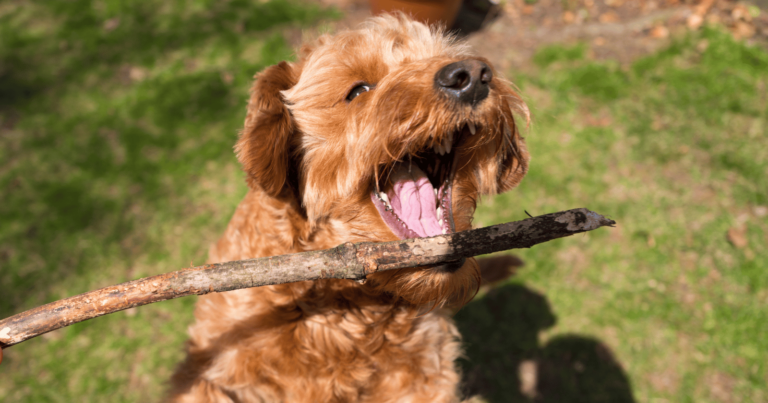Training your dog goes beyond the basic commands.
This is not about turning your dog into a circus performer, but about enhancing communication, trust and respect between you both.
Teaching advanced tricks and commands can help you do just that.
It’s not about showing off, but about building a stronger bond with your four-legged friend.
So, if you’re ready to up your dog training game, I’ve got a list of 8 advanced tricks and commands that will definitely keep those tails wagging.
1. Fetching specific items
When it comes to advanced tricks and commands, fetching specific items is a great place to start.
Most dogs know the basic fetch command. But imagine your dog fetching your slippers, or your newspaper, on command — how amazing would that be?
The key here is to start with objects your dog is naturally drawn to.
Then, gradually introduce them to new items by name.
Remember, patience is key.
And the reward of seeing your dog master this trick is well worth the effort.
This command is not just about showing off your dog’s skills.
It’s about enhancing their mental stimulation and effectively communicating your needs to them.
So why not give it a try?
Your furry friend might just surprise you.
2. The ‘silent’ command
Let me share a personal story.
My dog, Bella, is a bit of a barker.
Whether it’s the postman, a squirrel, or just a leaf blowing in the wind, Bella loves to voice her opinion.
I knew I needed to introduce an advanced command to help control this.
Enter the ‘silent’ command.
Teaching your dog to stop barking on command might seem like a daunting task, but it can be a game-changer.
I started by using a trigger word, “quiet,” every time Bella started barking unnecessarily.
Then, I would reward her with a treat when she stopped barking.
It took some time and consistency, but now Bella knows that “quiet” means she needs to stop her barking and remain calm.
It’s not just about keeping the peace in my home (and with my neighbors).
It’s about teaching Bella to understand and respond to my commands in different situations.
3. The ‘find it’ command

Dogs have an incredible sense of smell, far superior to ours.
To put it into perspective, a dog’s sense of smell is estimated to be between 10,000 to 100,000 times more sensitive than humans’.
This makes the ‘find it’ command a fantastic addition to your dog’s advanced training repertoire.
This command encourages your dog to use their keen sense of smell to locate a specific item.
Whether it’s a hidden toy or a favorite treat, ‘find it’ is an engaging mental exercise for your canine companion.
Start by hiding an item in an easy-to-find location and say “find it”.
Reward your dog when they locate the item.
Over time, make the task more challenging by hiding the item in more obscure locations.
Not only does this command provide mental stimulation for your dog, but it also taps into their natural instincts, making training fun and rewarding for you both.
4. The ‘stay’ command, with distractions
The ‘stay’ command is one of the first commands we teach our dogs.
But, taking it to the next level involves introducing distractions.
This advanced version of the command is excellent for ensuring your dog’s safety and discipline in situations with lots of distractions, like a busy park or when you have guests over.
Related Stories from Black Pearl Dogs
Start by practicing the standard ‘stay’ command, gradually increasing the distance between you and your dog.
Once they’ve mastered this, introduce minor distractions, like a bouncing ball or their favorite toy.
Reward them when they successfully stay despite the distraction.
Over time, you can introduce bigger distractions.
5. The ‘heel’ command
If you’ve ever struggled with a dog that pulls on the leash during walks, you’ll appreciate the ‘heel’ command.
This advanced command is all about teaching your dog to walk calmly by your side, without pulling on the leash.
Start by having your dog sit at your left side.
Then, as you step forward with your left foot, say ‘heel’ and begin walking. If your dog follows suit and stays by your side, reward them with a treat and praise.
Over time, your dog will start to associate the word ‘heel’ with the action of walking calmly beside you.
This command does more than just making walks more enjoyable; it also ensures your dog’s safety and teaches them to focus on you despite external distractions.
6. The ‘help’ command

There’s a special bond between humans and their dogs, a bond that’s often built through mutual care and assistance.
This is where the ‘help’ command comes in.
Teaching your dog to help around the house not only makes them feel useful, but it also strengthens that unique bond you share.
This could be as simple as teaching them to pick up their toys or as complex as fetching a bottle of water from the fridge.
I remember teaching Bella this command.
She was an eager learner, always wanting to please.
When she mastered picking up her toys, the pride in her eyes was unmistakable.
And for me, knowing that she felt valued and useful was truly heartwarming.
7. The ‘leave it’ command
The ‘leave it’ command can be a lifesaver in situations where your dog is about to pick up something harmful, like a piece of chocolate or a sharp object.
This command teaches your dog to immediately stop what they’re doing and focus on you.
It’s an advanced trick that requires patience and consistency to master, but it’s incredibly useful.
Start by holding a treat in your closed hand and say ‘leave it’.
Once your dog stops trying to get the treat and pulls away, reward them with a different treat from your other hand.
Over time, you can practice this command with different items and in various environments.
The goal is for your dog to associate the ‘leave it’ command with the action of stopping what they’re doing and looking at you.
8. The ‘off’ command
When it comes to advanced dog training, the ‘off’ command is essential.
This command is used to teach your dog to get off furniture, refrain from jumping on people, or stop engaging in any unwanted behavior.
It’s more than just a command; it’s about showing respect for your space and the space of others.
To teach this command, wait for your dog to jump up on something, say ‘off’ firmly (but without shouting), and then lure them off with a treat or toy.
When all four paws are on the ground, give them the reward.
The ‘off’ command requires consistency and patience.
But once mastered, it can significantly improve your dog’s manners and make cohabitation much more harmonious.
It’s all about connection
There’s an old saying that dogs are man’s best friend, and there’s a profound truth in that. Dogs offer us unwavering loyalty, endless affection, and unconditional love.
In return, we strive to understand them better, to communicate more effectively with them.
Teaching your dog advanced tricks and commands is a pathway to achieving this understanding.
Each command is not just a learned behavior; it’s a step towards a deeper connection, a shared language that helps bridge the gap between two different species.
Whether it’s fetching specific items or responding to an emergency recall, each command builds on this shared language, enhancing trust and mutual respect.













